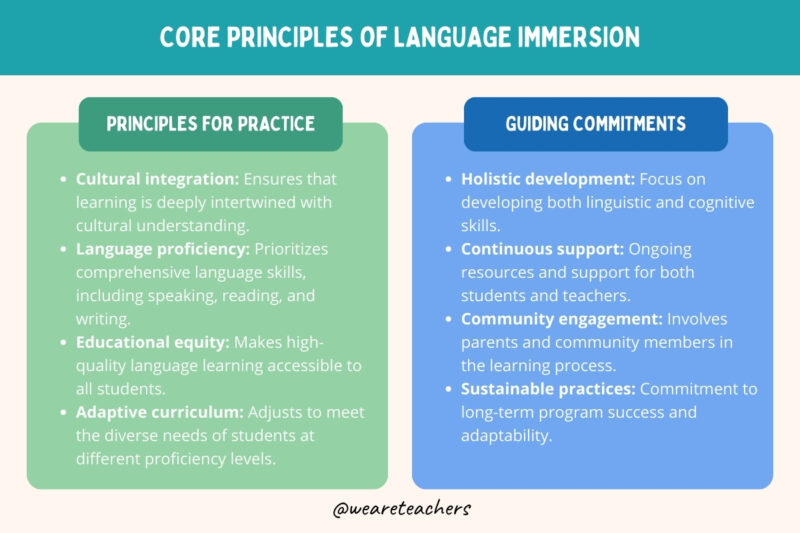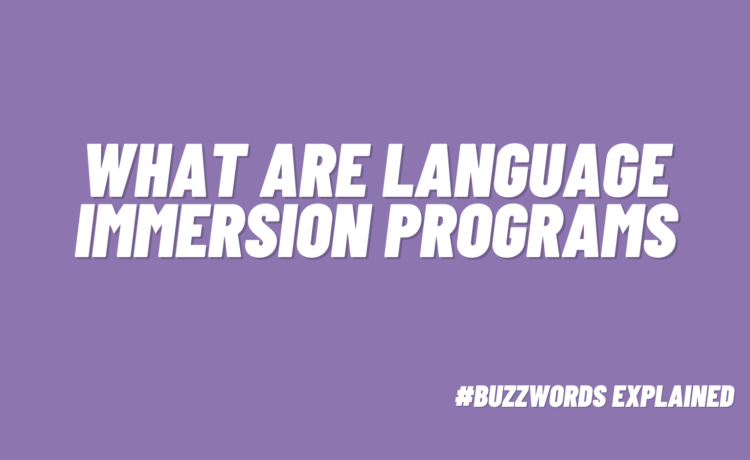In recent years, language immersion programs have gained popularity across the United States, reflecting a growing recognition of the benefits of multilingualism in a globalized world. These programs, where students are taught subjects in a second language, offer a unique educational approach that’s different from traditional language classes. By integrating language learning with standard curriculum subjects, we empower students to achieve fluency while also gaining academic knowledge.
What are language immersion programs?
Language immersion programs involve teaching students in a target language for at least half of their school day. These programs are designed to foster fluency in a second language. This is achieved by integrating language learning with the teaching of subject content. Students learn mathematics, science, social studies, and other subjects in the target language. This allows them to acquire language skills in a natural and meaningful context.
In the United States, there are four different types of language immersion programs:
- Foreign language immersion for kids who speak English at home
- Dual language programs for both English speakers and speakers of the target language
- Developmental bilingual programs that target children who speak a non-English language at home
- Indigenous immersion programs designed to revitalize endangered Native languages
These programs have emerged as a transformative educational approach that goes beyond traditional language learning. They submerge students in a second language environment, promoting fluency through natural communication and cultural exposure.
Benefits of Language Immersion Programs

Students who participate in these types of programs reap specific benefits and rewards. Let’s look at just a few of the positives associated with engaging in language immersion programs.
Cognitive Enhancement
Research indicates that students in language immersion programs often develop superior problem-solving skills and display higher creativity levels. This cognitive flexibility is a direct outcome of the brain’s adaptation to processing information in two languages.
Academic Performance
Studies have shown that immersion students typically meet or exceed the academic performance of their non-immersion peers on standardized tests conducted in their primary language. This suggests that the immersion method enhances overall academic abilities, not just language proficiency.
Cultural Competence
By learning a second language, students gain insights into and appreciation for other cultures, which fosters greater empathy and understanding. This cultural competence is increasingly important in our diverse society.
Long-Term Language Proficiency
Students who participate in immersion programs are more likely to achieve higher proficiency in the target language compared to those who study a language through traditional methods. This fluency can open up future educational and career opportunities.
Best Age for Language Immersion
Experts continue to debate over the best timing for introducing a second language. Many agree, however, that earlier is better when introducing a second language. Patricia Kuhl, co-director of the Institute for Learning & Brain Sciences, has highlighted the linguistic genius of babies. She shared how one study demonstrated how 6-month-old babies use sophisticated reasoning to understand their world.
Of course, enrolling an infant in a language immersion program is unlikely for most families. Early childhood (pre-K/kindergarten) is still considered ideal because young children are at a peak age for language learning. There are some ways, though, that we can improve the outcomes.
Implementing an Effective Language Immersion Program

Building a successful language immersion program requires a tailored approach to meet the needs of each school and its students. Drawing from the insights of Plutus Yang, an experienced educator and administrator at Hudson Way Immersion School, we outline the following key strategies for implementing a robust language immersion program.
Initially, students should be immersed fully in the target language. This replicates the natural language acquisition process they experienced with their native language. This deep immersion helps students start thinking and even dreaming in the new language, fostering a profound connection to it.
Progressive Language Weighting
Adopting a modified “90/10” model can be effective, where initially 90% of instruction is in the target language, gradually introducing more of the native language over time. This method ensures students do not neglect their native language skills while becoming proficient in the target language, ultimately aiming to produce balanced bilinguals.
Set Clear, Graduated Expectations
Language proficiency goals should be clearly defined for each academic year and should reflect the linguistic complexities of the target language. For example, students in a Chinese immersion program might not start forming full sentences until the end of the first year, whereas students in a Spanish immersion program might reach this milestone within the first few months.
Curriculum Development
Develop a curriculum that aligns with the set language proficiency expectations. For younger years, focus may be predominantly on oral language skills, progressively incorporating reading and writing as students advance. This ensures a well-rounded language education that builds proficiency gradually and effectively.
Leadership and Vision
Effective leadership is crucial. Ideally, the administrative team should include members who are not only experienced in immersion education but are also proficient in the target languages. This dual expertise allows for more informed decision-making and better support for both teachers and students.
Teacher Recruitment and Training
Hiring teachers with native proficiency in the target language is essential. Moreover, even experienced teachers new to the immersion setting should undergo specific training to adapt to the immersion philosophy and teaching methods. This includes understanding cultural nuances and maintaining a nurturing environment in the classroom.
Establish Educational Partnerships
Forming partnerships with local colleges can help create a pipeline of qualified bilingual teachers. These relationships can provide a steady influx of intern teachers trained in bilingual education, who are potential candidates for future full-time positions.
Parental Involvement and Communication
Parental support is vital for the long-term success of language immersion programs. Schools need to set realistic expectations for parents and regularly communicate the progress and challenges of the immersion experience. Parents should understand the commitment required and the gradual nature of language acquisition in such programs.
Continuous Evaluation and Adaptation
Regularly assess the effectiveness of the immersion program and make necessary adjustments based on student performance, feedback from teachers, and evolving educational standards. This iterative process helps maintain the program’s relevance and effectiveness.
Implementing these strategies can significantly enhance the success of a language immersion program, ensuring students not only learn a new language but also develop critical-thinking skills and cultural awareness that will benefit them throughout their lives. This comprehensive approach helps lay the foundation for students to become proficient bilinguals who are academically successful and culturally competent.















